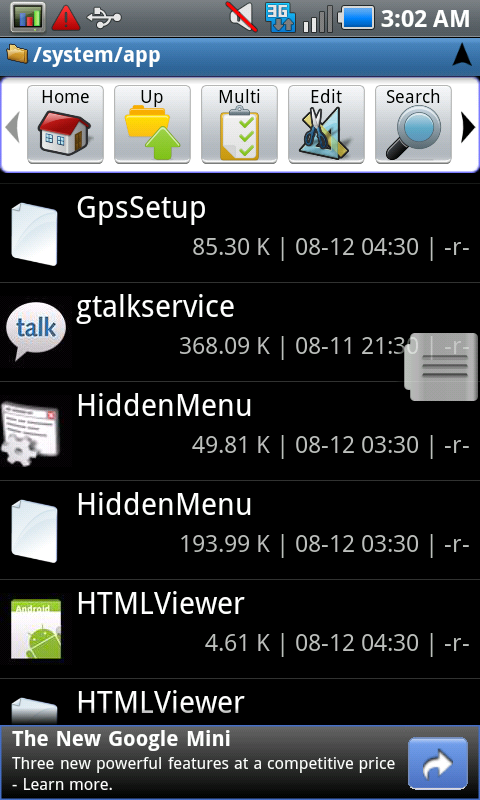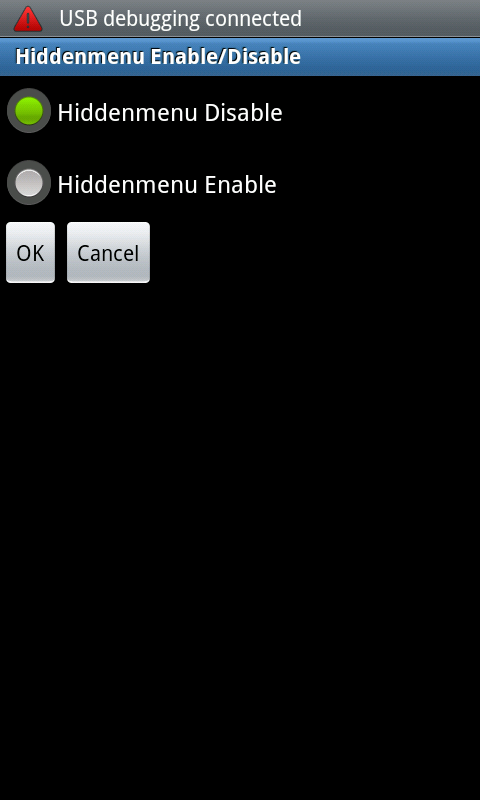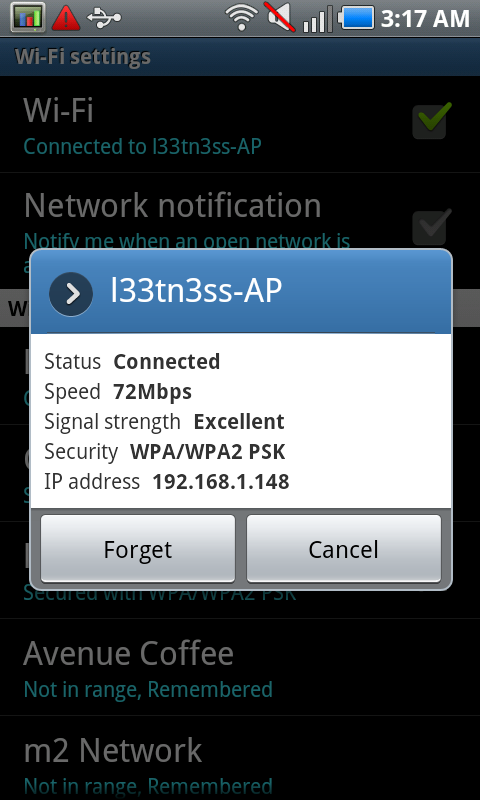Samsung Fascinate Review: Verizon's Galaxy S Smartphone
by Brian Klug on October 5, 2010 12:01 AM EST- Posted in
- Smartphones
- Samsung
- Galaxy S
- Fascinate
- Mobile
Cellular and WiFI Performance
The Fascinate doesn't have any antenna problems or weird baseband quirks. I experienced stable data connections and calls. We still run the phone through our now-regular tests to determine attenuation from holding devices in different positions.
| Signal Attenuation Comparison in dB—Lower is Better | |||||||
| Cupping Tightly | Holding Naturally | On an Open Palm | |||||
| Samsung Fascinate | 10.0 | 5.0 | 0.0 | ||||
| Droid 2 | 11.5 | 5.1 | 4.5 | ||||
| BlackBerry Torch | 15.9 | 7.1 | 3.7 | ||||
| Dell Streak | 14.0 | 8.7 | 4.0 | ||||
| Droid X | 15.0 | 5.1 | 4.5 | ||||
| iPhone 4 | 24.6 | 19.8 | 9.2 | ||||
| iPhone 3GS | 14.3 | 1.9 | 0.2 | ||||
| HTC Nexus One | 17.7 | 10.7 | 6.7 | ||||
The Fascinate (like the Epic 4G) seems to only expose signal changes in 5 dBm steps. Like Anand in the Epic review, I measure exactly the same thing. It's a bit frustrating to measure, but I managed to do so on the Fascinate after taking a lot of data - it didn't change. Unsurprisingly, attenuation is completely in line with what we've seen for other typical smartphones, sans iPhone 4. It's a bit frustrating that the radio stack doesn't show more granularity like other Android devices I've played with (all of them to date have showed me signal in 1 dBm steps), so I was determined to find more.
Just about every phone has special dialer codes. They're usually prefixed with "##" or asterisks, and just about every Android device has the somewhat famous "*#*#4636#*#*" special menu for doing basic things. The Captivate and Vibrant have gotten quite a bit of attention for having extremely thorough secret dialer codes, something I seriously favor in any device.
Regardless, I set out to discover whether any internal dialer codes could reveal more hardware information than I was seeing in Android through the UI and normal APIs.
To do so, I searched through the .apk files inside /system/app. Android package files are essentially zip files with a number of other files for the Android platform inside, including AndroidManifest.xml. Unfortunately, that XML file is encoded in binary, and requires some special unpacking. Regardless, I searched through and found lots of tasty goodness inside the ever so auspiciously-named hiddenmenu.apk file.

I found what I think are the Fascinate's internal codes, but none of the dialer prefixes I can think of work. Searching through everything in the Samsung GPL code repository for SCH-i500 (the Fascinate's model name) thoroughly revealed nothing either. The Samsung GPL code repository is here, just search SCH-i500 and you'll get the whole thing. It's possible that I missed the dialer code prefixes in there, but at the end of the day I couldn't find them. I also manually tried everything I could think of.
If you're so inclined, that AndroidManifest.xml file is up on pastebin here. There's a few interesting things inside. At the end of the day, however, I couldn't make anything work.
Update:
With the help of a friend with access to more information than I ;), I was able to finally figure out how to enable secret codes on the Fascinate. It's one of the most complicated procedures I've seen on a phone to date, but not impossible:
In the dialer, enter *#83786633 and tap the home button. Now, go back into the dialer, clear anything still in the dialer completely (the first code should still be there), and enter *#22745927. You'll be prompted for an SPC code, which should be 000000. Now you should get dumped to a screen like this:

Toggle enable, hit ok, and then things should work. This is the hiddenmenuenable apk I spent forever trying to get to. The dialing prefix is then *# with a suffix of # which is just like the other Galaxy S phones I've seen. Even then, the dialer codes are somewhat obfuscated - the only one I've found so far is #*4636*1111# which brings up the testing menu standard to other Android devices. I'm sure there are more out there.

Finally, I ran well over 100 speedtests on the Fascinate using the SpeedTest.net application, and averaged a downstream speed of 0.888 megabits/s, and upstream speed of 0.673 megabits/s. That's roughly in line with performance around town, with spikes up to 1.8 megabits/s of downstream near a tower.
WiFi Performance
The Fascinate negotiates a 72 megabit/s link with my 802.11N network - faster than the 65 megabits/s I've seen which is the bare minimum required to meet 802.11N requirements.

Wireless range on the Fascinate isn't quite as far as the EVO 4G or iPhone 4. I can make it a few more meters to the curb before falling off my AP on other devices. That said, the WiFi performance itself is not bad - 20 megabits/s on my 802.11n network downloading a 100 MB PDF.

There's also tethering support on the Fascinate, however the device I had time with wasn't provisioned for access and I couldn't test it. I could however get to the provisioning portal Verizon has, and that worked fine, but I couldn't tell if there were any hotspot issues like the Droid 2 had.










73 Comments
View All Comments
netmasterjohn - Tuesday, October 5, 2010 - link
How come Fascinate & Nexus One video are the same?dman - Tuesday, October 5, 2010 - link
I appreciate the testing methodology including the GPS fix times. I had an ATT Tilt (HTC 8925) which was notoriously slow in getting locked in. I got into the habit of starting the GPS app as soon as I'd get outdoors so that by the time I'd get to my vehicle it'd only have a couple minutes left. That and a few other workarounds. Sad that they still have issues these days...Chadder007 - Tuesday, October 5, 2010 - link
My Droid X came with a 16GB card, not 8.chemist1 - Tuesday, October 5, 2010 - link
Brian: Thanks for your reply. I'm pleased to hear you're trying to move in that direction. The idea of playing with CDMA voice codecs is intriguing -- I didn't occur to me that the audio quality (AQ) of smart phones could actually be user-modifiable at the software level. Though much of what determines AQ is hardware—the quality of the speaker in the earpiece, the circuitry upstream of it (and at the headphone jack output), the quality of the microphone (for those on the receiving end of your call), etc.More broadly, I like your general program of trying to put all areas that are now subjective onto a more objective footing. The problem with doing that for AQ is that it’s tricky. Often something can measure well, yet sound mediocre—which typically means that the measurements being used aren’t the right ones (for instance, maybe you’re measuring distortion, but the real problem is a phase error); or, alternately, perhaps the measurements aren’t being weighted properly. One solution is to supplement measurements with purely subjective, yet controlled, observations (a listening panel). You could also evaluate audio under compromised conditions by checking word recognition accuracy (but the danger here is that what might help accuracy under poor conditions—say, a boosted upper midrange—might make the phone fatiguingly harsh to listen to under normal conditions). Beyond that, I’d just reiterate what I said in my first post—I’d advise bringing in someone with a trained ear and/or lots of audio testing experience (if that's possible). [You can test for a trained ear by seeing if he/she can distinguish between different codecs in a single-blind test; or, alternately, perhaps you know, say, a recording engineer or a good classical pianist.]
Also, if you would, please ask Anand to read the Heijligers link I posted in my last comment, before he next tests iPods! [And you or he might wish to test the Redwine modification available for the 4G–5.5G iPods (http://redwineaudio.com/products/imod), to hear for yourselves what difference improved output circuitry can make in PMP AQ.]
Ranari - Tuesday, October 5, 2010 - link
*NOTE TO AUTHOR*Verizon and Microsoft have an advertising contract between each other, which is why you see Bing plastered all over the Samsung Fascinate. Businesses can control mobile ads in the Bing search engine using the Microsoft Adcenter. Mind you, this is over the Verizon network, but you can also see a few Bing mobile ads on m.bing.com, or if you download the Bing app on your smartphone. If you want a more Google experience, the other carriers will probably be your thing, but I find it to be more of an extension of the Android OS.
Personally, I think Bing has a pretty awesome mobile platform.
Aside from that, the review perfectly matches up with my thoughts about my Samsung Vibrant (T-Mobile).
-The Super AMOLED is absolutely gorgeous.
-The GPU is overkill, and I like it that way.
-Performance is great
-Battery life is mediocre
-And the GPS sucks bizalls
Cheers!
silverblue - Wednesday, October 6, 2010 - link
Sorry, didn't mean to be picky. :)anaxagoras1986 - Wednesday, October 6, 2010 - link
I'm not sure how the Galaxy is clearly better. It has a better GPU which is great, but only if you can use it. I don't play games so GPU performance is less important to me.Real-world performance with an Incredible (all of which are 2.2 now, why are you still testing or showing 2.1 results?) is close to the Nexus One 2.2 and HTC Evo 2,2. The charts show the 2.2 phones with a substantial performance advantage over the Galaxy.
So how is the Galaxy clearly better?
Doppleganger77 - Wednesday, October 6, 2010 - link
Even applying just the lag fix (fixes file system) to a 2.1 Galaxy S dramatically increases performance. For example, in the Quadrant benchmark I routinely achieve over 2200 points compared to about 800 for a standard Galaxy S. The Nexus One 2.2+ by comparison achieves around 1300 points. By applying a one click solution this phone can fly.ezinner - Thursday, October 7, 2010 - link
Arghh! I love the Galaxy S phones, but why oh why can't they put phone function buttons on the phone? Remember that this is still a phone and the most common functions are answer and end call!Jumpman23 - Saturday, October 9, 2010 - link
I always thought the iPhone ran at 1 GHz. So is 800MHz a typo or...